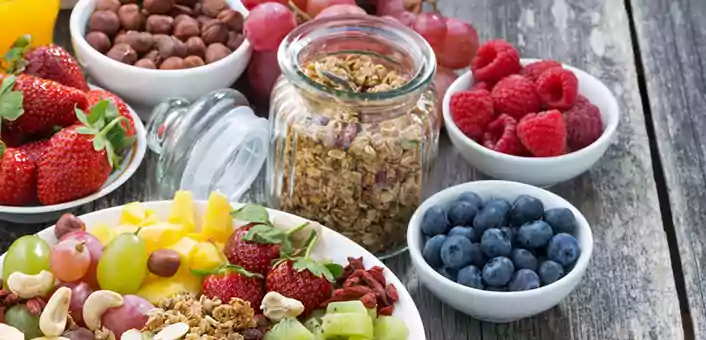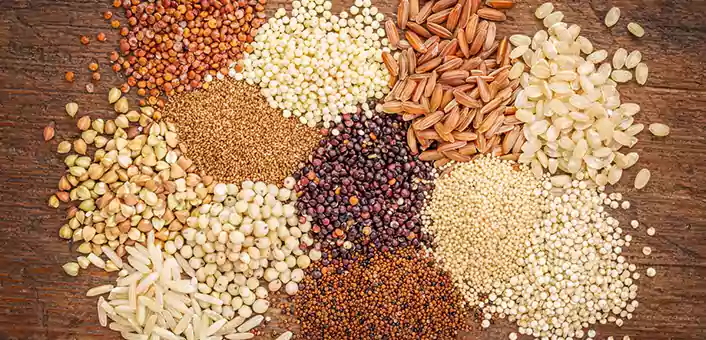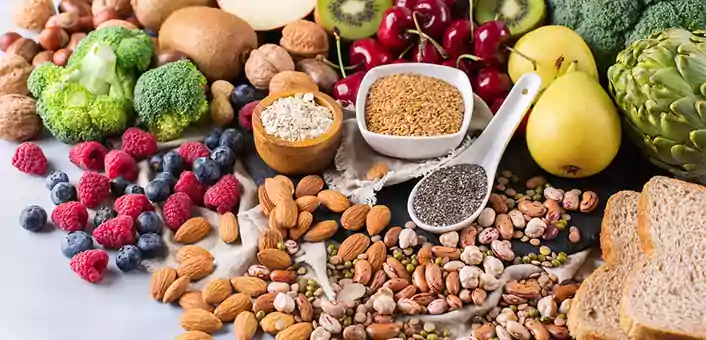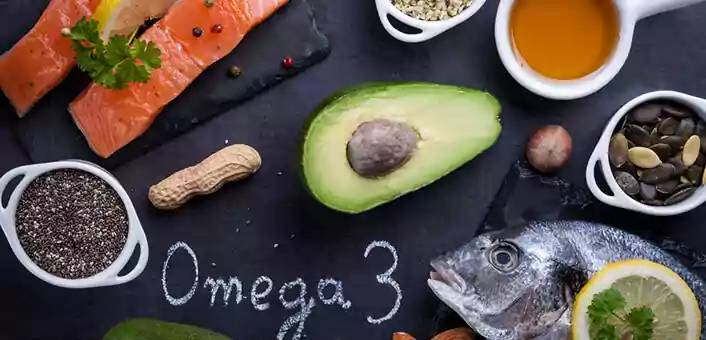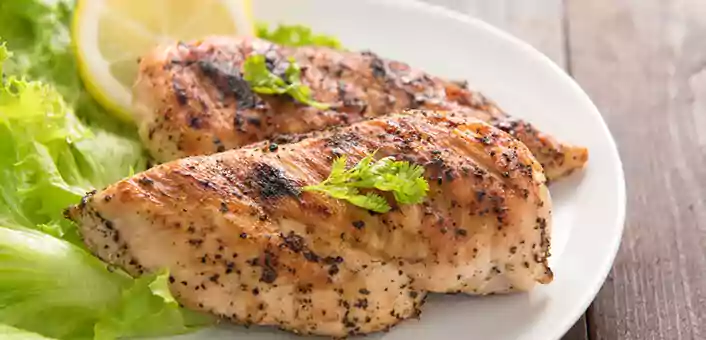
Diet
10 Diet Tips To Fight Insulin Resistance
Dec 27, 2017Insulin resistance is very commonly seen in people who have diabetes, Polycystic ovary syndrome (PCOS) or are obese. And there is something that links all these diseases together — a poor diet. Insulin resistance is a lifestylecondition, and your diet has a huge role to play here. In fact, changing your diet is one of the single-most effective ways to reverse insulin resistance, especially when it’s coupled with regular exercise, a good sleep hygiene and stress management. The right diet for insulin resistance can alter insulin signaling pathways to improve blood sugar control, help you lose weight, and also make you feel more energetic.
10 Principles For The Best Diet For Insulin Resistance
Fill Up On Whole Foods
The best diet for insulin resistance is one that focuses on eating a variety of raw, whole foods. If the food comes in a ready-to-eat packet, it has no business being on your plate! Processed foods and sugars are the WORST enemies of insulin resistance. They turn into simple sugars readily as they are highly processed to remove healthy fiber, making them digest rather quickly. Plus they are very high in calories, devoid of healthy nutrients, and can aid inflammation.
Instead, choose to eat more fresh vegetables, fruits, lean cuts of meat, wild-caught fish, healthy fats, nuts, and seeds. In fact, a Mediterranean diet can improve insulin sensitivity and heart health, as it focuses on whole foods – plenty of fruits and vegetables, along with quality fats and proteins.
Cut Back On Carbohydrates
All carbohydrates get broken down into sugars, which only worsen your insulin resistance. This is why it’s a good idea to cut back on your intake of carbohydrates, particularly of refined carbs. Refined carbohydrates with a high glycemic index are best avoided, as the body readily transforms them into simple sugars. However, that doesn’t mean that you cannot eat any carbs.
In fact, choosing the right source of carb is an essential part of any diet for insulin resistance. Vegetables and fruits are good sources of carbs for anyone suffering from insulin dysfunction. When choosing grains, complex carbohydrates like brown rice, quinoa, barley, steel-cut oats, whole-wheat breads, buckwheat, amaranth and millets are better choices. We do recommend a LCHF or Low Carb-High Fat diet to reverse insulin resistance.
Say No To Liquid Calories
While all sugars have the potential to worsen insulin resistance, some forms of sugar are worse than others. The worst offenders are sugary beverages — think colas, sweetened sodas, bottled iced teas and fruit juices that have added fructose in them.
Studies have found that sugar-sweetened beverages significantly increase the risk of diabetes as they decrease insulin sensitivity and increase abdominal adiposity. So ditch all sugary beverages and instead choose to drink flavored water, coconut water, and herbal teas.
Increase Fiber Intake
Increasing your fiber intake will help improve insulin sensitivity. There is plenty of scientific evidence that finds fiber intake has a beneficial effect on both insulin sensitivity and adiposity. Research indicates that dietary fiber consumption improves insulin sensitivity and secretion of certain gut hormones. Also, fiber has a positive effect on various metabolic and inflammatory markers that are associated with the metabolic syndrome.
Increase your dietary fiber intake by eating more fiber-rich vegetables with their skin, legumes and beans, chia seeds, flaxseeds, sprouts, avocados, quinoa, brown rice and buckwheat. In fact, experts now suggest that grains should be consumed in a minimally refined form to reduce the incidence of diabetes, as that packs in more fiber.
Eat More Healthy Fats
When you cut back on carbohydrates, eating the right kinds of fats goes a long way towards keeping you nourished and satiated. Don’t be afraid of fats, as the right dietary fats will actually help improve insulin sensitivity and aid in weight loss. The best fats are Omega 3 fatty acids, which improve insulin sensitivity and lower plasma triglyceride levels. Eat 2-3 servings of wild-caught fatty fish like salmon, sardines, mackerel, tuna or herring every week to boost your omega 3 intake. Other foods rich in omega 3 fatty acids include walnuts, flaxseeds, & egg yolks.
Studies have found that a change from polyunsaturated to monounsaturated diet in type 2 diabetes reduced insulin resistance, which also explains the benefits of a Mediterranean‐type diet. Ditch refined vegetable oils and switch to olive and avocado oil. Also, the right saturated fats like ghee, coconut oil, and grass-fed butter should be a part of your diet for insulin resistance.
Choose The Right Proteins
Eating adequate proteins will help keep you full as proteins digest slower than carbohydrates and don’t cause a spike in blood sugar levels. A diet that includes enough proteins will also help promote weight loss and prevent cravings. The best proteins are lean cuts of meat like poultry without skin and lean cuts of red meats. Fish is another great source of proteins as are eggs. If you are vegetarian or vegan, plant-based proteins like soy, beans, legumes, tempeh, and nuts are all good options.
Focus On A Few Key Minerals

Some minerals play a key role towards improving insulin sensitivity, so it’s a good idea to boost intake through diet. Zinc has been associated with improved insulin sensitivity and can also play an important role in appetite regulation as it stimulates the production of leptin (a hunger hormone.) Oysters, grass-fed lamb and beef, shellfish, cashews, chickpeas, and pumpkin & flax seeds are all good sources of zinc.
You could also easily be deficient in magnesium, which only contributes to insulin resistance. Increasing dietary magnesium intake can improve insulin resistance, according to trial studies. All leafy green vegetables like kale, kelp, spinach, and chard are rich in magnesium, as are nuts and seeds. Quinoa, buckwheat, and oats are other good natural sources of magnesium. Also, getting more Vitamin D and calcium in your diet can help improve insulin sensitivity.
Try These Supplements
The right dietary supplements increase your intake of nutrients that support your body’s ability to use insulin and can help keep your blood sugar stable. We recommend CoQ10 supplementation, D-Chiro Inositol, Chromium, ALA, Green Tea Extract and Pomegranate Extract to improve insulin resistance. Flaxseed, ginseng, cinnamon and fenugreek also have a positive effect on the glycemic control and can easily be supplemented through diet.
Listen To Your Body
A healthy diet for insulin resistance will only work when you give your body proper nourishment. We don’t believe in calorie counting, as it can make any diet become too cumbersome and seem more overwhelming. This is why, we believe that you should eat when you’re hungry and stop eating when you’re full — be keyed into your body’s needs. Don’t overeat just to get certain foods into your diet and don’t count calories. Just listen to your body.
In fact, portion control comes naturally when you choose the right grains, proteins and fats. Strive to eat in moderation. To achieve satiety, eat slowly and chew your food, so your brain has a chance to let you know when you’re full.
Give Intermittent Fasting A Try
When you want to reverse insulin resistance through diet, knowing when NOT to eat is almost as important as knowing when and what to eat. We strongly believe in intermittent fasting to help improve insulin sensitivity. Intermittent fasting is a simple strategy – eat during a 12-hour window, and fast during the remaining 12 hours.
It’s a good idea to create a 12 hour gap between dinner and breakfast next morning. Eating this way follows the natural body rhythms of the human body, giving the digestive system a much-needed rest for 12 hours. It also helps our cells get more sensitized to insulin during the ‘eating window’. Intermittent fasting is safe when done correctly, and very effective in aiding weight loss as well as increasing metabolism.
If you are looking for an insulin resistance diet menu, try this 3 Day Sample Diabetes Diet Plan to help you get started.
Final Thoughts
There’s a reason that diabetes and insulin resistance have become chronic epidemic diseases today. Most allopathic treatments and medication focus on lowering your insulin levels to combat insulin resistance without addressing your diet.
This approach simply addresses the symptoms, which means glucose levels in the body are manipulated through medications, without actually addressing the root cause behind insulin resistance — a diet too rich in sugars and wrong kinds of carbohydrates.
It’s only when you adopt a diet for insulin resistance that you’ll see long-term improvements without the need for medication.
Do you have insulin resistance? Have you tried any diet for insulin resistance that really worked? We’d love to hear from you!
References:
Mediterranean diet and insulin sensitivity, lipid profile and blood pressure levels, in overweight and obese people; The Attica study – https://lipidworld.biomedcentral.com/articles/10.1186/1476-511X-6-22
Consuming fructose-sweetened, not glucose-sweetened, beverages increases visceral adiposity and lipids and decreases insulin sensitivity in overweight/obese humans – https://www.ncbi.nlm.nih.gov/pubmed/19381015/
Dietary Glycemic Index and Glycemic Load, Carbohydrate and Fiber Intake, and Measures of Insulin Sensitivity, Secretion, and Adiposity in the Insulin Resistance Atherosclerosis Study – http://care.diabetesjournals.org/content/28/12/2832.short
Dietary Fiber, Glycemic Load, and Risk of Non—insulin-dependent Diabetes Mellitus in Women – https://jamanetwork.com/journals/jama/article-abstract/414104
Metabolic Effects of Dietary Fiber Consumption and Prevention of Diabetes – http://jn.nutrition.org/content/138/3/439.long
Diabetes and the Mediterranean diet: a beneficial effect of oleic acid on insulin sensitivity, adipocyte glucose transport and endothelium‐dependent vasoreactivity – https://academic.oup.com/qjmed/article/93/2/85/1517901
Dietary supplementation of omega-3 polyunsaturated fatty acids improves insulin sensitivity in non-insulin-dependent diabetes – http://europepmc.org/abstract/med/3038454
Effects of Dietary Coconut Oil on the Biochemical and Anthropometric Profiles of Women Presenting Abdominal Obesity – https://link.springer.com/article/10.1007/s11745-009-3306-6
Dietary proteins in obesity and in diabetes – https://www.ncbi.nlm.nih.gov/pubmed/22139563
Effect of zinc supplementation on serum leptin levels and insulin resistance of obese women – https://link.springer.com/article/10.1385/BTER:112:2:109
Magnesium deficiency produces insulin resistance and increased thromboxane synthesis – http://hyper.ahajournals.org/content/21/6_Pt_2/1024.short
Dietary Magnesium Intake Improves Insulin Resistance among Non-Diabetic Individuals with Metabolic Syndrome Participating in a Dietary Trial – http://www.mdpi.com/2072-6643/5/10/3910
